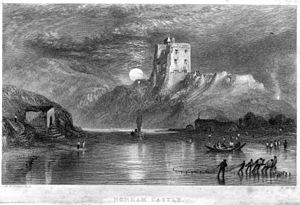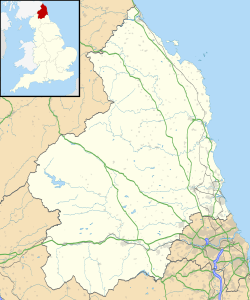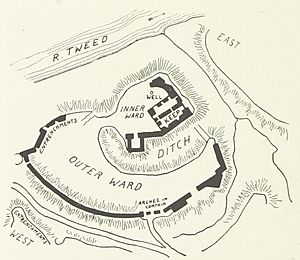Norham Castle facts for kids
Quick facts for kids Norham Castle |
|
|---|---|
| Northumberland, England, UK | |
 |
|
 |
|
|
Location in Northumberland
|
|
| Coordinates | 55°43′19″N 2°08′56″W / 55.722°N 2.149°W |
Norham Castle is an old castle in Northumberland, England. It stands high above the River Tweed, right on the border between England and Scotland. This castle was super important because it protected England from attacks by the Scots for hundreds of years.
Norham Castle is a very special historic building. It's listed as a Grade I listed building, which means it's one of the most important historical sites in England. It's also a Scheduled Ancient Monument, meaning it's protected by the government. The castle saw a lot of fighting during the many wars between England and Scotland.
Contents
Building Norham Castle: Its Early Days
Who Built Norham Castle?
The castle was first built in 1121. Ranulf Flambard, who was the Bishop of Durham at the time, ordered its construction. He wanted a strong fortress to protect the church's lands in northern Northumberland from Scottish raids.
Early Attacks and Rebuilding Efforts
In 1136, David I of Scotland invaded Northumberland and captured Norham Castle. It was given back to the bishopric soon after. But then, in 1138, the Scots attacked again and captured it once more. This time, they badly damaged the castle.
Norham Castle stayed in ruins for a while. Then, Hugh de Puiset, who became Bishop of Durham in 1153, decided to rebuild it. The work was probably managed by an architect named Richard of Wolviston.
Norham Castle Under Royal Control
In 1174, Bishop Hugh de Puiset joined a rebellion against King Henry II. During this time, the Scottish king, William the Lion, invaded Northumberland. The rebels lost, and as a result, Bishop Hugh had to give Norham Castle to the king.
For some years, the castle was managed by a royal officer and guarded by royal soldiers. This continued until 1197, when it was given back to the new Bishop of Durham, Philip of Poitou. He was very loyal to King John. When Philip died in 1208, the castle went back under royal control.
Norham Castle in the 1200s
Royal Visits and Strong Defenses
In 1209, both King John of England and William the Lion of Scotland met at Norham Castle. William showed his loyalty to the English king for his lands in England.
Between 1208 and 1211, King John made sure the castle's defenses were strong and had a large group of soldiers guarding it. These strong defenses were really needed in 1215. That year, Alexander II of Scotland, William the Lion's son, tried to capture the castle. He besieged it for forty days, but he couldn't take it.
In 1217, Norham Castle was given back to the Bishop of Durham once again.
Edward I and Scottish Homage
King Edward I, who was known as “Hammer of the Scots,” visited Norham Castle more than once. In 1292, John Balliol, the King of Scotland, came to Norham to show his loyalty to King Edward there.
In 1296, King Edward invaded Scotland. During his campaign, his queen, Marguerite of France, stayed safely at Norham Castle.
Norham Castle in the 1300s: Many Sieges
Facing Robert the Bruce
The early 1300s were a busy time for Norham Castle. The Scots invaded Northumberland many times. In 1318, Robert the Bruce besieged the castle for almost a year! His army managed to get into the outer part of the castle for three days, but they were then forced out. The siege failed.
In 1319, the Scots returned and tried to capture the castle again. Norham successfully held out against a seven-month siege. In 1322, there was yet another unsuccessful Scottish siege. During all three of these long sieges, the castle was bravely defended by Sir Thomas Grey of Heton.
A Brief Capture
In 1327, a Scottish army did manage to capture Norham Castle. However, it was soon returned to Lewis de Beaumont, the Bishop of Durham, when peace was agreed upon.
Norham Castle in the 1400s: Wars of the Roses
Keeping Up Defenses
The first half of the 1400s was a bit quieter for Norham Castle. But its defenses were always kept in good repair, just in case.
During the Wars of the Roses
The castle saw a lot of action during the Wars of the Roses (1455–1487). This was a series of civil wars in England between two powerful families, the Yorkists (who had a white rose as their symbol) and the Lancastrians (who had a red rose).
In 1462, Norham Castle was held by the Yorkists for King Edward IV. The next year, a Lancastrian army besieged the castle for eighteen days. Luckily, Yorkist forces arrived and rescued the castle. In 1464, the soldiers holding Norham Castle switched sides to support the Lancastrians. But they were soon forced to surrender to a Yorkist army.
Artillery Attacks
Later in the century, Bishop Richard Foxe of Durham (1494–1501) made the castle's defenses even stronger. In 1497, the castle was besieged for two weeks by an army led by James IV of Scotland. This siege was serious because the Scots used powerful cannons to try and break down the walls. But the castle's defenders were finally saved by an English army. After this latest siege, the castle was repaired again. One of the huge cannons used in that siege was called Mons Meg, which is now at Edinburgh Castle.
Norham Castle in the 1500s: Decline and Ruin
The Fall of Norham in 1513
In 1513, James IV of Scotland invaded England again with a very strong army and many cannons. He crossed the border and attacked Norham Castle. His cannons pounded the outer defenses for several days until the Scots took the outer part of the castle. Soon after, the castle surrendered. Most of the outer walls were destroyed by then.
Weeks later, King James was defeated and killed at the Battle of Flodden, near Branxton in Northumberland. Norham Castle then fell back into English hands.
Repairs and Inspections
After the battle, the castle was inspected by William Frankelayn, a chaplain for Cardinal Wolsey, in 1515. He found it well-fortified. The wall from the main tower (the Keep) towards the kitchen was incredibly thick, about 28 feet!
Bishop Thomas Ruthall of Durham began restoration work on the castle, which continued until 1521. In 1523, during another scare of a Scottish invasion, the Earl of Surrey ordered new earthwork defenses to be built, using turf and earth to fix broken parts of the walls.
A Place of Refuge
In 1528, Archibald Douglas, 6th Earl of Angus, a Scottish nobleman, was threatened by his step-son, James V of Scotland. He asked for rooms in Norham Castle for his daughter, Margaret Douglas, and other family members. If needed, Angus himself would seek safety there. Margaret Douglas, who would later be the grandmother of James I of England, was indeed welcomed at Norham in October. The Earl of Northumberland made sure that the Douglas family members would not be allowed into the most secure inner parts of the castle.
The Castle's Decline
Norham Castle was kept in good repair and had a strong group of soldiers during the remaining conflicts with Scotland in the 1500s. However, when a long period of peace began between England and Scotland, the number of soldiers was reduced, and the castle's defenses were allowed to get worse.
By the end of the century, the castle was already falling apart. In 1596, Queen Elizabeth said she would not spend any money on Norham Castle.
Norham was also a place where border officials often met. But the castle was not destined to see any more fighting. It was given to George Home, 1st Earl of Dunbar by King James I when he became king of England. After that, the castle was left to fall into ruin.
Norham Castle in the 1800s
A Famous Subject for Artists
In the 1800s, Norham Castle became very well known because of the beautiful paintings by J. M. W. Turner, a famous artist. He first painted the castle in 1797 and returned many times to paint it again. You can see several of his paintings of Norham Castle in the Tate Gallery in London.

What Norham Castle Looks Like Today
Norham Castle stands on the south bank of the River Tweed. It's built high above the river, so the north side is naturally protected by a steep slope. A deep ditch (ravine) protected the east side. An artificial moat (a water-filled ditch) was dug around the west and south sides to complete the castle's protection.
The castle had two main parts: an inner ward and an outer ward. The inner ward was built on a raised mound and was separated from the outer ward by a moat. You would cross a drawbridge to get between them.
Entering the Castle
The main entrance to the castle was the very strong West Gate, which led into the outer ward. It was protected by a stone path and a drawbridge. This gate is also known as "Marmion's Gate." There was another gate on the south side of the outer ward, called the Sheep Gate.
To enter the inner ward, you would cross a drawbridge over the moat and go through a fortified gate on the west side. Today, a wooden bridge has replaced the old drawbridge.
Key Buildings Inside
On the north side of the inner ward were the bishop's hall, which was a large building for important meetings and feasts. It measured about 60 feet by 30 feet, but it is now in ruins.
On the east side of the inner ward stands the keep, which is the main tower of the castle. It measures about 84 feet by 60 feet and is 88 feet high. The keep is believed to have been built by Hugh de Puiset.
Norham Castle is now looked after by English Heritage, a charity that cares for historic places. It is open for visitors to explore and learn about its long and exciting history.
Images for kids





